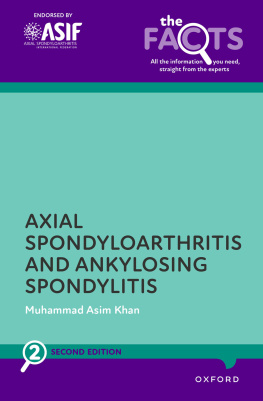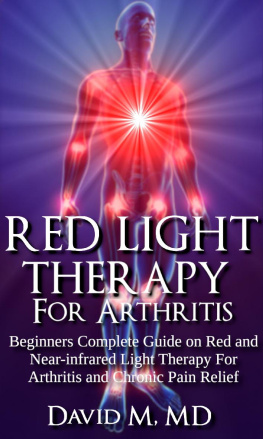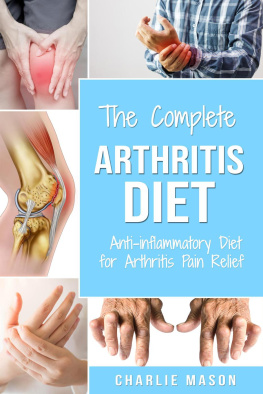thefacts
Ankylosing
Spondylitis
and Axial
Spondyloarthritis
 also available in the facts series
also available in the facts series
Lung Cancer: the facts
THIRD EDITION
Falk and Williams
Psoriatic Arthritis: the facts
Gladman and Chandran
Schizophrenia: the facts
FOURTH EDITION
Glatt, Faraone, and Tsuang
The Pill and other forms of hormonal contraception: the facts
SEVENTH EDITION
Guillebaud and MacGregor
Myotonic dystrophy: the facts
SECOND EDITION
Harper
Alzheimers and other Dementias: the facts
Hughes
Lupus: the facts
SECOND EDITION
Isenberg and Manzi
Angina and Heart Attack: the facts
Jevon
Ankylosing Spondylitis and Axial Spondyloarthritis: the facts
SECOND EDITION
Khan
Borderline Personality Disorder: the facts
Krawitz and Jackson
Inflammatory Bowel Disease: the facts
Langmead and Irving
Back Pain: the facts
Lee, Brook, and Daniel
Stroke: the facts
SECOND EDITION
Lindley
Alcoholism: the facts
FOURTH EDITION
Manzardo, Goodwin, Campbell, Penick, and Gabrelli
Prostate cancer: the facts
SECOND EDITION
Mason and Moffat
Diabetes: the facts
Matthews, Meston, Dyson, Shaw, King, and Pal
Skin Conditions in Young People: the facts
McPherson
Essential tremor: the facts
Plumb and Bain
Osteoarthritis: the facts
SECOND EDITION
Prieto-Alhambra, Arden, and Hunter
Huntingtons Disease: the facts
THIRD EDITION
Quarrell
Panic disorder: the facts
THIRD EDITION
Rachman and de Silva
Obsessive-compulsive disorder: the facts
FOURTH EDITION
Rachman and de Silva
Post-traumatic Stress: the facts
SECOND EDITION
Regel and Joseph
Tourette syndrome: the facts
SECOND EDITION
Robertson and Cavanna
Breast Cancer: the facts
SECOND EDITION
Saunders, Jassal, and Lim
Dyslexia and other learning difficulties: the facts
THIRD EDITION
Selikowitz
Down Syndrome: the facts
THIRD EDITION
Selikowitz
ADHD: the facts
THIRD EDITION
Selikowitz
Sleep problems in Children and Adolescents: the facts
Stores
Motor neuron disease: the facts
Talbot and Marsden
Cystic fibrosis: the facts
FOURTH EDITION
Thomson and Harris
Thyroid disease: the facts
FOURTH EDITION
Vanderpump and Tunbridge
Depression: the facts
SECOND EDITION
Wassermann
Cosmetic surgery: the facts
Waterhouse

Great Clarendon Street, Oxford, OX2 6DP,
United Kingdom
Oxford University Press is a department of the University of Oxford. It furthers the Universitys objective of excellence in research, scholarship, and education by publishing worldwide. Oxford is a registered trade mark of Oxford University Press in the UK and in certain other countries
Oxford University Press 2023
The moral rights of the author have been asserted
First Edition published in 2002
Second Edition published in 2023
Impression: 1
All rights reserved. No part of this publication may be reproduced, stored in a retrieval system, or transmitted, in any form or by any means, without the prior permission in writing of Oxford University Press, or as expressly permitted by law, by licence or under terms agreed with the appropriate reprographics rights organization. Enquiries concerning reproduction outside the scope of the above should be sent to the Rights Department, Oxford University Press, at the address above
You must not circulate this work in any other form and you must impose this same condition on any acquirer
Published in the United States of America by Oxford University Press
198 Madison Avenue, New York, NY 10016, United States of America
British Library Cataloguing in Publication Data
Data available
Library of Congress Control Number: 2022938866
ISBN 9780198864158
eISBN 9780192609717
DOI: 10.1093/oso/9780198864158.001.0001
Oxford University Press makes no representation, express or implied, that the drug dosages in this book are correct. Readers must therefore always check the product information and clinical procedures with the most up-to-date published product information and data sheets provided by the manufacturers and the most recent codes of conduct and safety regulations. The authors and the publishers do not accept responsibility or legal liability for any errors in the text or for the misuse or misapplication of material in this work. Except where otherwise stated, drug dosages and recommendations are for the non-pregnant adult who is not breast-feeding
Links to third party websites are provided by Oxford in good faith and for information only. Oxford disclaims any responsibility for the materials contained in any third party website referenced in this work.
Dedication
I dedicate this book to my father, Umar Khan, my mother, Hameeda Khanam, and to her father, Sadr-ud-Din Khan (a high school principal who retired as inspector of schools) for having inculcated in me the passion to pursue knowledge and impart it to others. They all worked tirelessly to re-establish when we became refugees, uprooted from our ancestral lands when I was a little over three years old. Therefore, I also dedicate this book to all the refugees like me in this world who may still be longing for a home, and most of them also happen to share my faith.
Advance praise
Written for patients by a patient who is also a leading authority on spondyloarthritis, this book is an essential reference and reading for people living with axial spondyloarthritis with ankylosing spondylitis as its prototypeand their caregivers who want to learn about the disease and how to manage it well.
Michael Mallinson,
Patient Advocate and Volunteer,
Axial Spondyloarthritis International Federation (ASIF)
Preface
There have been tremendous advances in clinical understanding, early disease recognition, and more effective management of ankylosing spondylitis (AS) and related diseases. The advent of newer imaging methods, such as magnetic resonance imaging (MRI) and very low-dose computerized tomography (CT), have also facilitated early diagnosis and initiation of increasingly more effective (but costly) drugs called biologics (administered by injection under the skin or by intravenous infusion), and most recently JAK-inhibitors that are taken orally as tablets. These drugs target inflammatory proteins (cytokines), such as tumor necrosis factor (TNF) and interleukin-17 (IL-17).
All these new development and progress in diagnosis and management of AS and related diseases has necessitated this second edition of the book. I have updated its title by adding the term Axial Spondyloarthritis that requires some explanation.
The term spondyloarthritis (or SpA) refers to a family of chronic inflammatory non-contagious (non-infectious) forms of arthritis involving the spine and the limbs that share many of their clinical features and genetic predisposing factors. Those patients with SpA who primarily have inflammation of the joints and ligaments of the back and neck (i.e., the axial skeleton) are now sub-classified as having axial spondyloarthritis (axSpA); whereas those with involvement predominantly of the peripheral (distal) limb joints (other than hip and shoulder joints that are part of the axial skeleton), are labeled as having peripheral SpA. The typical example of axSpA is AS, while that of peripheral SpA is psoriatic arthritis (PsA).













 also available in the facts series
also available in the facts series